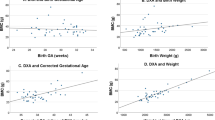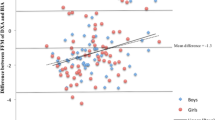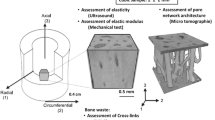Abstract
Background/Objectives:
To assess bone status using quantitative ultrasound (QUS) applied to the second metacarpus and to evaluate the influence of vitamin D supplementation on bone mineralization in exclusively breast-fed infants.
Subjects/Methods:
Seventy seven healthy exclusively breast-fed infants aged <12 months underwent QUS evaluation with QUS DBM Sonic Aurora IGEA (MO, Italy), which measures speed of sound (mcSoS) and bone transmission time (mcBTT). Z-scores for age and length were also considered. Infants were divided into two groups, considering vitamin D supplementation.
Results:
mcSoS and mcBTT were significantly lower in the group of breast-fed infants without vitamin D supplementation (respectively, P=0.001 and P=0.015). A statistically significant difference was also observed between the two groups for Z-scores of QUS parameters for age and length, with lower levels in infants not supplemented with vitamin D. Both mcSoS and mcBTT decline during the first year of life. mcSoS inversely correlated with weight at enrollment and BMI at enrollment.
Conclusions:
Our data support the importance of vitamin D supplementation in exclusively breast-fed infants in the first period of life to provide an adequate bone development.
This is a preview of subscription content, access via your institution
Access options
Subscribe to this journal
Receive 12 print issues and online access
$259.00 per year
only $21.58 per issue
Buy this article
- Purchase on Springer Link
- Instant access to full article PDF
Prices may be subject to local taxes which are calculated during checkout
Similar content being viewed by others
References
Andiran N, Yordam N, Ozon A (2002). Risk factors for vitamin D deficiency in breast-fed newborns and their mothers. Nutrition 18, 47–50.
Barkmann R, Rohrschneider W, Vierling M, Troger J, De Terlizzi F, Cadossi R et al. (2002). German pediatric reference data for quantitative transverse transmission ultrasound of finger phalanges. Osteoporos Int 13, 55–61.
Baroncelli GI (2008). Quantitative ultrasound methods to assess bone mineral status in children: technical characteristics, performance, and clinical application. Pediatr Res 63, 220–228.
Baroncelli GI, Federico G, Bertelloni S, de Terlizzi F, Cadossi R, Saggese G (2001). Bone quality assessment by quantitative ultrasound of proximal phalanxes of the hand in healthy subjects aged 3–21 years. Pediatr Res 49, 713–718.
Butte N, Lopez-Alarcon MG, Garza C (2002). Nutrient Adequacy of Exclusive Breastfeeding for the Term Infant during the First Six Months of Life. World Health Organization: Geneva.
Callaghan AL, Moy RJ, Booth IW, Debelle G, Shaw NJ (2006). Incidence of symptomatic vitamin D deficiency. Arch Dis Child 91, 606–607.
Fogelman I, Blake GM (2000). Different approaches to bone densitometry. J Nucl Med 41, 2015–2025.
Gartner LM, Morton J, Lawrence RA, Naylor AJ, O’Hare D, Schanler RJ, et al. American Academy of Pediatrics Section on Breastfeeding (2005). Breastfeeding and the use of human milk. Pediatrics 115, 496–506.
Gonnelli S, Montagnani A, Gennari L, Martini S, Merlotti D, Cepollaro C et al. (2004). Feasibility of quantitative ultrasound measurements on the humerus of newborn infants for the assessment of the skeletal status. Osteoporos Int 15, 541–546.
Guglielmi G, Adams J, Link TM (2009). Quantitative ultrasound in the assessment of skeletal status. Eur Radiol 19, 1837–1848.
Hochberg Z, Bereket A, Davenport M, Delemarre-Van de Waal HA, De Schepper J, Levine MA, et al. European Society for Paediatric Endocrinology (ESPE) Bone Club (2002). Consensus development for the supplementation of vitamin D in childhood and adolescence. Horm Res 58, 39–51.
Hollis BW, Wagner CL (2004). Vitamin D requirements during lactation: high-dose maternal supplementation as therapy to prevent hypovitaminosis D for both the mother and the nursing infant. Am J Clin Nutr 80 (Suppl 6), 1752S–1758S.
James DC, Lessen R (2009). Position of the Dietetic American Association: promoting and supporting breastfeeding. J Am Diet Assoc 109, 1926–1942.
Javaid MK, Cooper C (2002). Prenatal and childhood influences on osteoporosis. Best Pract Res Clin Endocrinol Metab 16, 349–367.
Kimball S, Fuleihan Gel-H, Vieth R (2008). Vitamin D: a growing perspective. Crit Rev Clin Lab Sci 45, 339–414.
Lips P (2006). Vitamin D physiology. Prog Biophys Mol Biol 92, 4–8.
McDevitt H, Tomlinson C, White MP, Ahmed SF (2005). Quantitative ultrasound assessment of bone in preterm and term neonates. Arch Dis Child Fetal Neonatal Ed 90, F341–F342.
Park MJ, Namgung R, Kim DH, Tsang RC (1998). Bone mineral content is not reduced despite low vitamin D status in breast milk-fed infants versus cow's milk based formula-fed infants. J Pediatr 132, 641–645.
Ritschl E, Wehmeijer K, DE Terlizzi F, Wipfler E, Cadossi R, Douma D et al. (2005). Assessment of skeletal development in preterm and term infants by quantitative ultrasound. Pediatr Res 58, 341–346.
Rubinacci A, Moro GE, Boehm G, De Terlizzi F, Moro GL, Cadossi R (2003). Quantitative ultrasound for the assessment of osteopenia in preterm infants. Eur J Endocrinol 149, 307–315.
Specker BL (1994). Do North American women need supplemental vitamin D during pregnancy or lactation? Am J Clin Nutr 59 (Suppl 2), S484–S490.
Vignolo M, Brignone A, Mascagni A, Ravera G, Biasotti B, Aicardi G (2003). Influence of age, sex, and growth variables on phalangeal quantitative ultrasound measures: a study in healthy children and adolescents. Calcif Tissue Int 72, 681–688.
Wagner CL, Greer FR, American Academy of Pediatrics Section on Breastfeeding; American Academy of Pediatrics Committee on Nutrition (2008). Prevention of rickets and vitamin D deficiency in infants, children, and adolescents. Pediatrics 122, 1142–1152.
World Health Organization (2001). Global Strategy for Infant and Young Child Feeding, The Optimal Duration of Exclusive Breastfeeding. World Health Organization: Geneva.
WHO/UNICEF/IFPRI/UCDavis/FANTA/AED/USAID (2008). Indicators for Assessing Infant and Young Child Feeding Practices. Part 1: Definitions. World Health Organization: Geneva.
Wren TA, Gilsanz V (2006). Assessing bone mass in children and adolescents. Curr Osteoporos Rep 4, 53–58.
Author information
Authors and Affiliations
Corresponding author
Ethics declarations
Competing interests
The authors declare no conflict of interest.
Rights and permissions
About this article
Cite this article
Savino, F., Viola, S., Tarasco, V. et al. Bone mineral status in breast-fed infants: influence of vitamin D supplementation. Eur J Clin Nutr 65, 335–339 (2011). https://doi.org/10.1038/ejcn.2010.274
Received:
Revised:
Accepted:
Published:
Issue Date:
DOI: https://doi.org/10.1038/ejcn.2010.274



